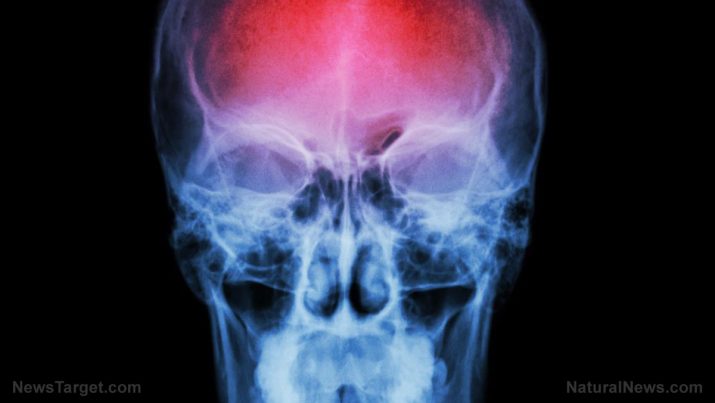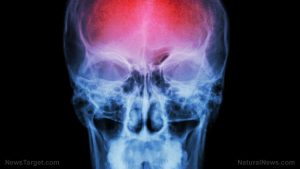
Stroke – causes, side effects and treatments at NaturalPedia.com
Wednesday, July 04, 2018 by Ralph Flores
http://www.naturalpedia.com/stroke-causes-side-effects-and-treatments-at-naturalpedia-com.html

The term “stroke” refers to the condition where the blood supply to the brain (or part of it) is interrupted or reduced, causing a lack of oxygen and nutrients. A stroke is a medical emergency, as brain cells begin to die within minutes. Early action and prompt treatment can reduce brain damage as well as potential complications.
Strokes are classified into two main types:
- A hemorrhagic stroke happens when a blood vessel in the brain bursts, causing internal bleeding. This type of stroke is uncommon; however, it most often results in death.
- An ischemic stroke, on the other hand, is the result of a clot obstructing the flow of blood to the brain.
Another condition that mimics stroke-like symptoms is called transient ischemic attack (TIA). This appears fast and can disappear in as little as 24 hours.

Known risk factors and symptoms of stroke
A method used the world over to recognize the signs of a stroke is the mnemonic F.A.S.T.
- Face – The face appears to have dropped on one side (including the mouth and the eye), and the person is unable to smile.
- Arms – A person will not be able to lift both arms for an extended period because of weakness or numbness in one arm.
- Speech – If a person is suspected to have a stroke, his speech will be slurred and garbled; he may even be unable to talk despite appearing to be awake.
- Time – If the person exhibits any of the symptoms above, call emergency services immediately. (In the U.S., the number is 911; In the U.K., it’s 999.)
Common risk factors include high blood pressure and high cholesterol, as well as diabetes. Smoking and illicit drug use also increase the likelihood of having a stroke, as well as increasing age. People who have conditions such as atrial fibrillation, patent foramen ovale, and heart valve disease are also more likely to suffer a stroke.
A genetic condition called homocystinuria – where the body produces abnormally high levels of the chemical homocysteine – can also make a person predisposed to having a stroke.
Body systems affected by stroke
Common complications after a stroke include:
- Brain edema – swelling of the brain
- Pneumonia – a result of being unable to move after a stroke
- Urinary tract infection and bladder control problems
- Seizures – common in larger strokes, where abnormal electrical activity leads to convulsions
- Clinical depression
- Bedsores – ulcers that come from being unable to move specific areas of the body
- Limb contractions and pain – typically caused by paralysis and arm weakness
- Deep venous thrombosis (DVT) – blood clots in the veins of the legs due to immobility
Food items or nutrients that may prevent or relieve stroke
In the event of a stroke, proper nutrition is vital to avoid severe complications and help the person recover. Here are some herbal treatments that may help improve a person’s condition after a stroke.
- Chinese motherwort – In traditional Chinese medicine (TCM), the aerial parts are used to treat stroke, heart attack, and menstrual problems.
- Baikal skullcap – The herb, known in TCM as huangquin, may help people recover from a stroke by binding to receptors and block neurodegenerative processes.
- Ginseng – The root is an adaptogen, which boosts the body’s defenses against stress and disease. Studies have shown that it stimulates the production of new neurons after a stroke.
Treatment and management options for stroke
For the most part, stroke is a preventable disease. Here are some lifestyle changes that a person can do to reduce the likelihood of stroke.
- Lower blood pressure. Cutting back on salt; reducing the consumption of high-cholesterol processed foods; and eating at least four to five cups of fruits and vegetables each day, a serving of fish two to three times a week, and adding whole grains in the diet can reduce the risk of stroke in both men and women. Exercise also helps, especially a daily minimum of 30 minutes of moderate activity. If a person smokes, it’s advisable that he quit immediately.
- Lose weight. Maintaining an active lifestyle and watching what you eat can help you lose weight. Studies have shown that losing as little as 10 pounds, for starters, can significantly reduce the risk of stroke.
- Exercise more. Having at least 30 minutes of moderate exercise can help improve the body’s blood pressure. A good benchmark is to exercise to a level where you breathe hard, but you are still able to talk.
- Keep alcohol in moderation. A glass of red wine could decrease the risk of stroke. Any higher and the risk goes up sharply.
- Manage atrial fibrillation. A person should consult with his healthcare professional to see if he has signs of atrial fibrillation – which can increase the likelihood of stroke by five times.
- Treat diabetes. Keeping your blood sugar in check makes it less likely for blood clots to form and cause an ischemic stroke.
- Quit smoking. It increases plaque buildup in the arteries which can travel and block the blood vessels in the brain.
Where to learn more
- Women who suffer from migraines at higher risk of a stroke
- Folic acid supplements can reduce the risk of stroke by 73% in hypertensive patients
- Merck stops production of osteoporosis drug over stroke concerns, has yet to stop vaccine production
- Migraine sufferers at higher risk of stroke
- SNORT ATTACK: Cocaine raises your chance of having a STROKE 6 TIMES… crack is 8 times!
Summary
A stroke happens when the blood supply to the brain is interrupted or reduced. This causes a lack of oxygen and nutrients.
A stroke is a medical emergency, and early action and prompt treatment can reduce brain damage.
There are two type of strokes: hemorrhagic (where a blood vessel in the brain bursts) and ischemic (the result of a clot obstructing the flow of blood).
The mnemonic F.A.S.T. (face, arms, speech, and time) is commonly used to identify stroke symptoms.
Sources include:
Tagged Under: Tags: stroke





